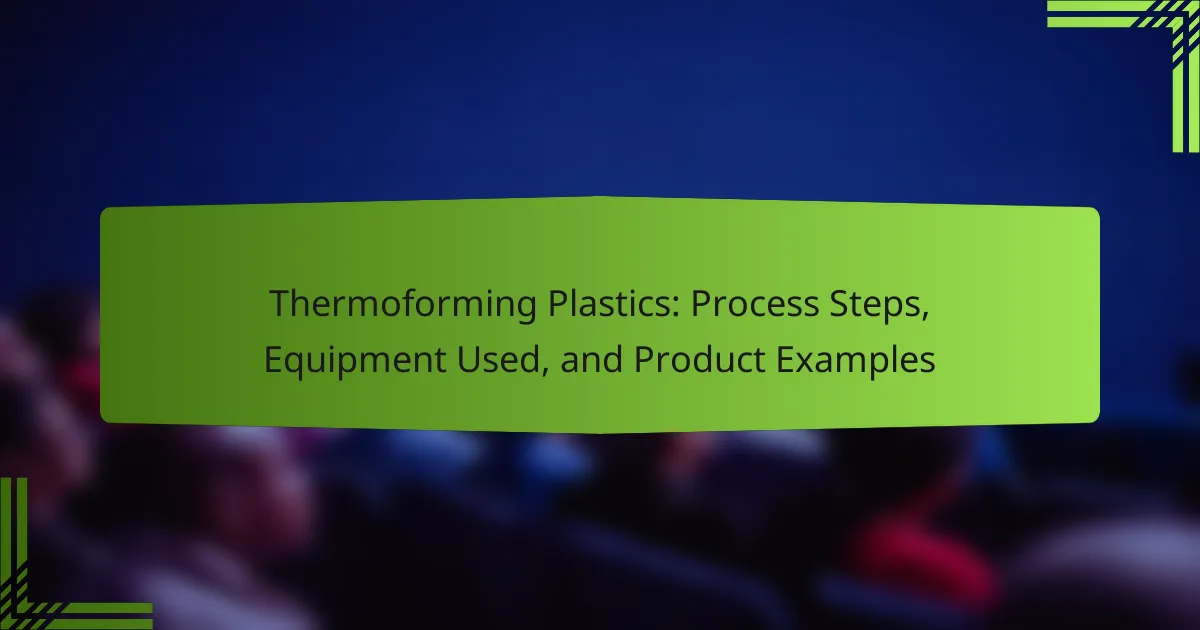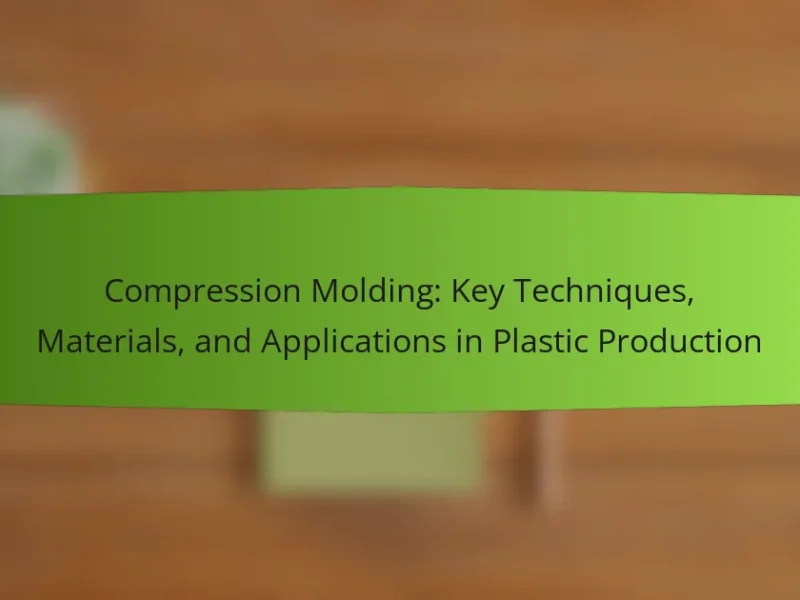Thermoforming plastics is a plastic processing technique that shapes plastic sheets through heating, molding, and cooling. The article outlines the thermoforming process, detailing the essential equipment involved, such as thermoforming machines, vacuum systems, heating elements, cooling systems, molds, and cutting tools. It also provides examples of products created using this method, including packaging trays, clamshell containers, medical device housings, and automotive components. The versatility and cost-effectiveness of thermoforming make it a widely adopted technique across various industries.

What is Thermoforming Plastics?
Thermoforming plastics are a type of plastic processing technique used to shape plastic sheets. This process involves heating a plastic sheet until it becomes pliable. Once softened, the sheet is formed over a mold and then cooled to retain the shape. Thermoforming is commonly used for creating packaging, trays, and automotive parts. The efficiency of this method allows for rapid production and minimal waste. It is widely utilized in various industries due to its versatility and cost-effectiveness.
How does the Thermoforming process work?
The thermoforming process works by heating a plastic sheet until it becomes pliable. This heated sheet is then formed over a mold using vacuum or pressure. Once the plastic cools, it retains the shape of the mold. The process typically involves several steps: heating, forming, cooling, and trimming.
During heating, the sheet is uniformly warmed to a specific temperature. The forming stage uses either vacuum or pressure to shape the plastic. In vacuum forming, air is removed from beneath the sheet, allowing it to conform to the mold. Pressure forming uses air pressure to push the sheet against the mold.
After forming, the plastic is cooled to solidify its shape. Finally, trimming removes any excess material from the edges. This process is efficient for producing large quantities of consistent parts. It is widely used in packaging, automotive, and consumer products.
What are the key stages in the Thermoforming process?
The key stages in the thermoforming process include heating, forming, cooling, and trimming. In the heating stage, plastic sheets are heated to a pliable temperature. This allows the material to be easily shaped. The forming stage involves using molds to shape the heated plastic into desired forms. During cooling, the formed plastic is allowed to solidify. Finally, in the trimming stage, excess material is removed to achieve the final product shape. Each stage is crucial for ensuring the quality and precision of the thermoformed item.
What types of plastics are commonly used in Thermoforming?
Commonly used plastics in thermoforming include polystyrene, polyethylene, polycarbonate, and PVC. Polystyrene is popular for its versatility and cost-effectiveness. Polyethylene offers excellent impact resistance and flexibility. Polycarbonate is known for its high strength and clarity. PVC is favored for its durability and ease of processing. Each of these plastics has specific applications due to their unique properties.
Why is Thermoforming important in manufacturing?
Thermoforming is important in manufacturing because it allows for the efficient production of plastic parts. This process involves heating plastic sheets until they become pliable. Once softened, the sheets are formed over molds to create specific shapes. Thermoforming is widely used due to its versatility and cost-effectiveness. It can produce large quantities of parts quickly. Additionally, thermoforming minimizes material waste compared to other methods. Industries such as packaging, automotive, and consumer goods benefit from this manufacturing technique. The ability to create complex shapes with precision enhances product design and functionality.
What advantages does Thermoforming offer over other plastic forming methods?
Thermoforming offers several advantages over other plastic forming methods. It allows for faster production cycles compared to injection molding. Thermoforming is also cost-effective for low to medium volume production. This method requires less expensive tooling, which reduces initial setup costs. Additionally, it can accommodate larger sheet sizes, making it suitable for bigger parts. Thermoforming provides excellent design flexibility, allowing for complex shapes and features. The process enables easy recycling of scrap material, promoting sustainability. These benefits make thermoforming a preferred choice for various applications in packaging and automotive industries.
How does Thermoforming contribute to sustainability in manufacturing?
Thermoforming contributes to sustainability in manufacturing by reducing material waste and energy consumption. This process allows manufacturers to create products using thin sheets of plastic, minimizing excess material. Thermoforming typically uses less energy than other manufacturing methods, such as injection molding. Studies show that thermoforming can achieve up to 50% energy savings compared to traditional methods. Additionally, thermoformed products can be made from recycled plastics, further enhancing sustainability. The ability to recycle and reuse materials helps decrease the environmental impact of manufacturing.

What equipment is used in the Thermoforming process?
Thermoforming uses several key pieces of equipment. The primary equipment includes a thermoforming machine, which heats plastic sheets and shapes them. A vacuum system is essential to create a vacuum that molds the heated plastic to a form. Heating elements are used to warm the plastic sheets evenly. A cooling system is necessary to solidify the shaped plastic. Additionally, molds are required to define the final shape of the product. Cutting tools are used to trim excess material after forming. Each piece of equipment plays a critical role in ensuring an efficient thermoforming process.
What are the main types of Thermoforming machines?
The main types of thermoforming machines are vacuum forming machines, pressure forming machines, and twin-sheet forming machines. Vacuum forming machines use a vacuum to draw heated plastic sheets into molds. This process is efficient for creating simple shapes. Pressure forming machines apply pressure to the plastic sheet, allowing for more detailed designs and thicker materials. Twin-sheet forming machines utilize two sheets of plastic, heating and forming them simultaneously to create hollow parts. Each type serves different applications in the thermoforming process, catering to various product requirements.
How do different Thermoforming machines operate?
Different thermoforming machines operate by heating plastic sheets and shaping them into desired forms using molds. The process begins with the heating of the plastic sheet until it becomes pliable. Once heated, the sheet is transferred to a mold. The mold can be either male or female, depending on the desired shape.
Vacuum forming is a common method where a vacuum pulls the heated sheet onto the mold. Pressure forming uses air pressure to push the sheet into the mold for more intricate shapes. Some machines may utilize a combination of both methods for enhanced detail and accuracy.
After forming, the plastic cools and solidifies in the mold. The formed part is then ejected from the mold for further processing or trimming. This operation method allows for high production rates and versatility in product design.
What features should be considered when choosing Thermoforming equipment?
When choosing thermoforming equipment, consider the machine type, heating method, and material compatibility. The machine type affects production speed and flexibility. Common types include vacuum forming and pressure forming. Heating methods can be radiant, conduction, or convection, impacting energy efficiency and heating uniformity. Material compatibility is crucial; equipment must accommodate various thermoplastics like ABS, PVC, or PET.
Additionally, consider the equipment’s size, which affects the dimensions of products that can be formed. The level of automation is another feature; fully automated systems enhance efficiency but may require higher initial investment. Maintenance requirements should also be evaluated to ensure long-term operational efficiency. Lastly, the manufacturer’s support and warranty can influence the decision, providing assurance for repairs and service.
What auxiliary equipment is essential for Thermoforming?
Essential auxiliary equipment for thermoforming includes a heating system, vacuum system, and cooling system. The heating system is crucial for softening the plastic sheets to the desired temperature. A vacuum system is necessary for creating the vacuum that helps form the heated plastic over molds. The cooling system is important for solidifying the formed plastic into its final shape. Additional equipment may include a trimming system for cutting excess material and a control system for monitoring temperature and pressure. These components work together to ensure efficient and effective thermoforming processes.
What role do heating elements play in Thermoforming?
Heating elements are crucial in thermoforming as they provide the necessary heat to soften thermoplastic materials. This softening allows the plastic to be molded into specific shapes. Typically, heating elements are integrated into machines to deliver consistent and controlled temperatures. The precise heating ensures uniform material properties during the forming process. According to industry standards, optimal heating temperatures vary depending on the type of thermoplastic used. For instance, ABS plastics require temperatures around 180°C to 220°C. This controlled heating is essential for achieving desired thickness and clarity in the final product.
How does cooling equipment affect the Thermoforming process?
Cooling equipment is crucial in the thermoforming process as it affects the final product’s quality and dimensional stability. Proper cooling ensures that the formed plastic retains its shape after being molded. Insufficient cooling can lead to warping or distortion of the final product. Effective cooling systems help to control the temperature of the material, allowing for consistent processing. This consistency is vital for achieving uniform thickness and preventing defects. Additionally, cooling equipment can reduce cycle times, enhancing production efficiency. Studies show that optimized cooling can improve overall product strength and durability.

What are some examples of products made from Thermoforming plastics?
Examples of products made from thermoforming plastics include packaging trays, clamshell containers, and medical device housings. These products are often made from materials such as polystyrene, polycarbonate, and PVC. Packaging trays are commonly used in food packaging. Clamshell containers provide a secure way to store and display products. Medical device housings protect sensitive equipment. Other examples are automotive interior components and custom display fixtures. These products leverage the versatility of thermoforming processes to achieve specific shapes and functionalities.
What industries utilize Thermoformed products?
Thermoformed products are utilized across various industries. Key sectors include packaging, automotive, medical, and consumer goods. In packaging, thermoformed trays and containers are common for food and retail products. The automotive industry uses thermoformed parts for interior components and dashboards. Medical applications include custom trays and packaging for surgical instruments. Consumer goods often feature thermoformed items like clamshell packaging and display cases. Each industry benefits from the lightweight and cost-effective nature of thermoformed products.
What are common applications of Thermoformed plastics in packaging?
Common applications of thermoformed plastics in packaging include food containers, clamshells, and blisters. Food containers made from thermoformed plastics are lightweight and provide excellent insulation. Clamshell packaging is often used for fruits, vegetables, and baked goods, ensuring visibility and protection. Blister packs are commonly utilized for pharmaceuticals and consumer goods, offering tamper resistance and product visibility. These applications benefit from the versatility and cost-effectiveness of thermoformed plastics. The global market for thermoformed packaging was valued at approximately $30 billion in 2020, indicating strong demand across various sectors.
How are Thermoformed plastics used in automotive manufacturing?
Thermoformed plastics are widely used in automotive manufacturing for various components. They are commonly employed to create interior parts such as dashboards, door panels, and trim pieces. The process involves heating plastic sheets until pliable and then forming them into specific shapes using molds. This method allows for lightweight and durable components that can reduce vehicle weight and improve fuel efficiency. Additionally, thermoformed plastics offer design flexibility, enabling manufacturers to produce complex shapes and textures. The automotive industry benefits from the cost-effectiveness of thermoforming, as it allows for rapid production and reduced material waste. Studies show that using thermoformed plastics can enhance overall vehicle performance and sustainability.
What innovative products have emerged from Thermoforming technology?
Innovative products that have emerged from thermoforming technology include packaging solutions, automotive components, and medical devices. Thermoforming allows for the creation of lightweight and durable packaging materials. For instance, clamshell packaging is widely used in food and retail sectors. In the automotive industry, thermoformed parts like dashboards and door panels are produced for their cost-effectiveness and design flexibility. Additionally, medical trays and containers made through thermoforming enhance sterilization processes. These products demonstrate the versatility and efficiency of thermoforming in various applications.
What are some unique or niche applications of Thermoforming?
Thermoforming has unique applications in various industries. One niche application is in the medical field for creating custom trays and packaging for surgical instruments. This ensures sterility and organization during procedures. Another unique use is in the automotive industry for manufacturing lightweight interior components. These components help reduce overall vehicle weight and improve fuel efficiency. Additionally, thermoforming is utilized in the food packaging sector. It creates vacuum-sealed containers that extend shelf life and maintain freshness. In the electronics industry, thermoforming is employed to produce protective covers and enclosures. These covers safeguard sensitive components from dust and impact. Each of these applications demonstrates the versatility and efficiency of thermoforming in specialized markets.
How is technology advancing the capabilities of Thermoforming products?
Technology is advancing the capabilities of thermoforming products through improved materials and automation. Advanced polymers enhance durability and flexibility in thermoformed items. Innovations in heating technology allow for more uniform temperature distribution. This results in better material performance during the forming process. Automation in machinery increases production speed and precision. Automated systems reduce human error and improve consistency in product quality. Additionally, 3D printing integration enables rapid prototyping of complex designs. These advancements lead to greater customization options and reduced waste in production. Overall, technology is elevating the efficiency and versatility of thermoforming products.
What best practices should be followed in Thermoforming?
Best practices in thermoforming include proper material selection, precise temperature control, and accurate mold design. Selecting the right thermoplastic material ensures optimal forming characteristics and end-product quality. Maintaining precise temperature is crucial for achieving uniform material softening, which affects the forming process. Accurate mold design should consider factors like draft angles and surface finish to facilitate easy part removal and enhance product aesthetics. Additionally, using consistent pressure during forming helps maintain dimensional accuracy. Regular equipment maintenance prevents operational issues and ensures consistent production quality. Implementing quality control measures at each stage of the process identifies defects early and reduces waste.
How can manufacturers optimize the Thermoforming process for efficiency?
Manufacturers can optimize the thermoforming process for efficiency by implementing several strategies. First, they can invest in advanced heating technologies to ensure uniform temperature distribution. This reduces cycle times and minimizes material waste. Second, using high-quality materials with better thermal properties can enhance the forming process. This leads to improved product consistency and reduces the need for rework.
Additionally, optimizing mold design is crucial. Efficient mold designs can reduce cooling times and improve part accuracy. Implementing automation in the loading and unloading processes can also streamline operations. Studies show that automation can increase production rates by up to 30%.
Regular maintenance of equipment is essential for preventing downtime. Manufacturers should schedule routine checks to ensure all machinery operates at optimal levels. Lastly, training staff on best practices can improve overall process efficiency. Educated employees can identify and resolve issues quickly, further enhancing productivity.
What common challenges should be addressed in Thermoforming operations?
Common challenges in thermoforming operations include material selection, temperature control, and equipment calibration. Material selection affects the final product’s quality and performance. Inadequate temperature control can lead to warping or incomplete forming. Equipment calibration is essential for consistent results and preventing defects. Additionally, cycle time optimization is crucial for efficiency. Managing waste and ensuring proper tooling maintenance are also significant challenges. Addressing these issues can enhance product quality and operational efficiency.
Thermoforming plastics is a manufacturing process that involves heating plastic sheets until pliable, shaping them over molds, and cooling them to retain their form. The article covers the key stages of the thermoforming process, including heating, forming, cooling, and trimming, as well as the types of plastics commonly used. It highlights the importance of thermoforming in various industries such as packaging, automotive, and medical, emphasizing its advantages over other methods, including efficiency and sustainability. Additionally, the article discusses the equipment used in thermoforming, common applications, and best practices for optimizing the process.


